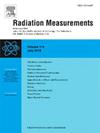Development and response characterization of new Bonner sphere spectrometer using lithium-glass scintillators coupled with current-integrating photomultiplier tubes
IF 2.2
3区 物理与天体物理
Q2 NUCLEAR SCIENCE & TECHNOLOGY
引用次数: 0
Abstract
A new Bonner sphere spectrometer (BSS) has been developed to measure the spectral fluence of high-intensity neutrons in boron neutron capture therapy facilities and radiation resistance test facilities for electronic devices. A pair of lithium-glass scintillators (GS20 and GS30) coupled with current-integrating photomultiplier tubes was adopted as a low-energy neutron detection element for the Bonner sphere detectors to compensate for the effects of γ-rays. The response matrix for the BSS was determined by Monte Carlo simulations of the response in pulse-counting mode and by using an experimentally determined conversion factor to convert the pulse-counting response to the current-integrating response. Since the new detector has geometric asymmetry, the directional dependence of the response functions was evaluated through experiments and Monte Carlo simulations. A significant directional dependence was observed, which is acceptable when neutrons from a single direction, but care must be taken when measuring neutrons originating from a wide range of directions.
锂-玻璃闪烁体耦合积流光电倍增管新型邦纳球光谱仪的研制与响应特性研究
研制了一种新型的邦纳球谱仪(BSS),用于测量电子设备中硼中子俘获治疗设备和耐辐射测试设备中高强度中子的光谱影响。采用一对锂玻璃闪烁体(GS20和GS30)耦合电流积分光电倍增管作为Bonner球探测器的低能中子探测元件,以补偿γ射线的影响。BSS的响应矩阵由脉冲计数模式下响应的蒙特卡罗模拟确定,并使用实验确定的转换因子将脉冲计数响应转换为电流积分响应。由于新型探测器具有几何不对称性,通过实验和蒙特卡罗模拟评估了响应函数的方向依赖性。观察到明显的方向依赖性,当中子来自单一方向时,这是可以接受的,但当测量来自广泛方向的中子时,必须小心。
本文章由计算机程序翻译,如有差异,请以英文原文为准。
求助全文
约1分钟内获得全文
求助全文
来源期刊

Radiation Measurements
工程技术-核科学技术
CiteScore
4.10
自引率
20.00%
发文量
116
审稿时长
48 days
期刊介绍:
The journal seeks to publish papers that present advances in the following areas: spontaneous and stimulated luminescence (including scintillating materials, thermoluminescence, and optically stimulated luminescence); electron spin resonance of natural and synthetic materials; the physics, design and performance of radiation measurements (including computational modelling such as electronic transport simulations); the novel basic aspects of radiation measurement in medical physics. Studies of energy-transfer phenomena, track physics and microdosimetry are also of interest to the journal.
Applications relevant to the journal, particularly where they present novel detection techniques, novel analytical approaches or novel materials, include: personal dosimetry (including dosimetric quantities, active/electronic and passive monitoring techniques for photon, neutron and charged-particle exposures); environmental dosimetry (including methodological advances and predictive models related to radon, but generally excluding local survey results of radon where the main aim is to establish the radiation risk to populations); cosmic and high-energy radiation measurements (including dosimetry, space radiation effects, and single event upsets); dosimetry-based archaeological and Quaternary dating; dosimetry-based approaches to thermochronometry; accident and retrospective dosimetry (including activation detectors), and dosimetry and measurements related to medical applications.
 求助内容:
求助内容: 应助结果提醒方式:
应助结果提醒方式:


